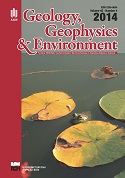Influence of platinum ions on phenolic compounds in Lepidium sativum seedlings
Main Article Content
Keywords
Lepidium sativum, heavy metals, PtCl4, [Pt(NH3)4](NO3)2, oxidative stress
Abstract
Despite limiting the transport emitted pollution, contamination of the roadside environment remains an important issue. Due to necessity of decrease the lead emission, catalytic converters modifications were introduced. It caused increase of Platinum Group Elements (PGEs) emission, which were rare in the environment before. It was proved that platinum present in the street dust and urban soils is bioavailable to plants. So far there is lack of information about platinum contamination to functioning of plants which are so important in the urban environment.
In the experiment garden cress (Lepidium sativum) were sown into Petri dishes filled with filter paper soaked with solutions of different platinum concentration (0, 1, 5, 10, 20 and 40 mg compound·dm-3). There were used two compounds containing platinum at different oxidation states Pt+4 (PtCl4)and Pt+2 ([Pt(NH3)4](NO3)2) in every combination of the experiment. In every combination there was five Petri dishes, experiment was repeated twice. To estimate plant response to stress factor, phenolic compounds content were analyzed in the roots and shoots parts separately.
The highest amount of total phenolics in roots were recorded in plants treated with highest Pt+4 dose which was 40mg compound·dm-3, other objects (including those treated with highest dose of Pt+2) did not differ significantly from control plants.
In the case of phenolic compounds in the aboveground parts of seedlings there was highest accumulation than in roots. Highest amounts of phenolics were recorded in plants also treated with Pt+4 in doses 20 and 40 mg compound·dm-3.
Downloads
References
Bhaduri A.M. & Fulekar M.H., 2012. Antioxidant enzyme responses of plants to heavy metal stress. Reviews in Environmental Science and Biotechnology, 11, 1, 55-69.
Fukumoto L. & Mazza G., 2000. Assesssing antioxidant and prooxidant activities of phenolic compounds. Journal of Agricultural and Food Chemistry, 48, 8, 3597-3604.
Hameed N., Siddiqui Z.S. & Ahmed S., 2001. Effects of Copper and Lead on Germination, Accumulation and Phenolic Contents of Spinancea oleracea and Lycopersicum esculentum. Pakistan Journal of Biological Sciences, 4, 7, 809-811.
Hooda P.S., Miller A. & Edwards A.C., 2007. The distribution of automobile catalysts-cast platinum, palladium and rhodium in soils adjacent to roads and their uptake by grass. Science of the Total Environment, 384, 1-3, 384-392.
Janecka B. & Fijałkowski K., 2008. Using Lepidium as a test of phytotoxicity from lead/zinc spoils and soil conditioners, [in:] Simeonov L. & Sargsyan V. (eds), Soil Chemical Pollution, Risk Assessment, Remediation and Security, NATO Science for Peace and Security, Springer Science+Business Media B.V., Dordrecht, 177-182.
Michalak A., 2006. Phenolic Compounds and Their Antioxidant Activity in Plants Growing under Heavy Metal Stress. Polish Journal of Environmental Studies, 15, 4, 523-530.
Morina F. Jovanovic L., Kukavica B. & Veljovic-Jovanovic S., 2008. Peroxidase, phenolics and antioxidative capacity of common mullein (Verbascum thapsus) grown in a zinc excess. Archives of Biological Sciences Belgrade, 60, 4, 687-695.
Mourato M., Reis R. & Louro Martins L., 2012. Characterization of Plant Antioxidative System in Response to Abiotic Stresses: A Focus on Heavy Metal Toxicity. [in:] Montanaro G. & Dichio B. (eds), Advances in Selected Plant Physiology Aspects, InTech, 24-44.
Ovecka M. & Takac T., 2014. Managing heavy metal toxicity stress in plants: Biological and biotechnological tools. Biotechnology Advances, 32, 1, 73-86.
Sobrova P., Zehnalek J., Adam V., Beklova M. & Kizek R., 2012. The effects on soil/water/plant/animal systems by platinum group elements. Central European Journal of Chemistry, 10, 5, 1369-1382.
Torabi S. & Khavarinejad R.A., 2014. Effects of manganese toxicity on activation of antioxidant enzymes, Anthocyanin and total phenolic content in Sunflower (Helianthus annuus L.). Annals of Biological Science 2, 3, 42-47.


